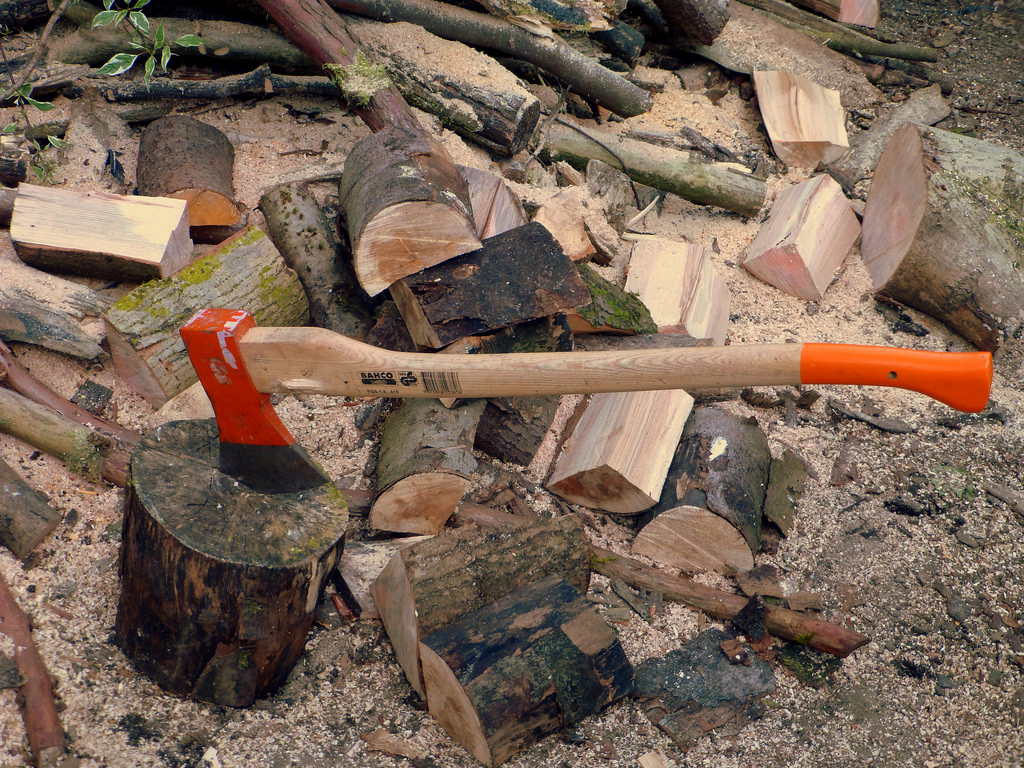Which tool should I choose for cutting firewood? Is this the question you have come with on your mind? If yes, this article is definitely meant for you. It is often confusing when it comes to choosing firewood cutting tools since there are different types of cutting devices. These tools are not meant for any cuttings rather different tools are intended for separate purposes with different features. With the situation, size and type of the woods, the selection of cutting tools gets varied in order to achieve optimum cutting efficiency.
However, people involved with woodworking should be able to distinguish various cutting tools with their specific use. Here are usages and purposes of several cutting instruments you must know to get your splitting jobs done efficiently.
Splitting Axe:
The most common and effective cutting tool is splitting axe, designed with the purpose of splitting wood along the grain, not across the grain. It comes with a tapered metal head that generally weighs 3-6 pounds and a long handle either made of wood in a traditional style or composite material, more durable than wooden ones. The wooden handle looks great and is more comfortable than a composite handle but breakable with over force or wrong use. To differentiate, a splitting axe is lighter than a maul.
The splitting axe is most suitable for slitting medium to large-sized logs or chopping branches into burnable length for firewood. This tool has perfect balance in weight distribution between the head and handle, resulting in the head swing down to strike the wood to split.
Splitting Maul:
A splitting maul is heavier and more powerful than an axe, which features a heavy metal head that weighs usually between 6-8 pounds. The main difference between a maul and an axe lies in shape of the head. The maul head, unlike axe head, is wider and V-shaped, which helps the blade not to stick into the wood, a common problem happening with axe. The edge of the head is duller than that of axe; the overweight behind blade makes this tool heavier, resulting in better cutting through long and hardwood.
Similar to axe handle, the maul handle is also made of either hickory wood or composite materials, sometimes plastic, but differs somewhat in functionality and design. The maul handle is longer than axe handle, not requiring you to lean towards the tree lying on the ground while splitting firewood.
This tool is recommended for large and long wood since it is heavier than others and gives more efficiency in every swing.
Splitting Wedge:
When the old hardwood resists with a typical splitting maul or axe, a splitting wedge is a must-need tool that is able to penetrate through the even hickory wood.
This is a small tool specially designed with a wedge shape in order to make the wood torn apart. Thanks to its special shape, it reduces energy consumption while splitting, digging into the wood and then striking with hammer or maul. The wedge is made of hand forged carbon steel for sturdy and efficient performance. Generally, the head of the wedge is sharp enough to cut off wood easily.
Splitting Hatchet:
Although a hatchet resembles an axe it differs noticeably in size and function. A hatchet is a small axe mostly used with one hand, and many people know it as hand axe. The head of the hatchet is narrow with wide cutting blade relatively, suitable for fine work. Since this tool is intended for chopping small branches and firewood, it is designed with lighter weight and small handle, requiring less backswing. Sometimes, a hatchet may have two heads, an edge and a hammer on the opposite.
It is easily portable and is able to cut from any angle, even in a small space. This tool would be a great choice for splitting small logs and fine works. A hatchet is a very ideal tool for a campaigner thanks to its portability.
Log Splitter:
It is nothing but a log splitter which splits more wood with less effort. A log splitter is a device used to split round logs into pieces suitable for the fireplace. It can split any kind of hard and softwood either seasoned or green. Any log splitter, powered or manual, produces force or energy to split woods and features piston or hydraulic or electric rod to generate pressure against a stationary blade or a metal surface.
Powered log splitters are generally driven by either an electric motor or by a diesel or gasoline engine whereas human power is enough to drive manual log splitter. Among all kinds of log splitters, gas log splitters are the most powerful which can produce up to 30 tons of force while electric log splitters have the capacity to produce 6-10 tons of force. Getting gas log splitters is better for professional usages, and electric ones would be a great choice for regular purpose.
The capacity of powered splitters varies depending upon motor capacity. It is better to choose motor capacity according to your needs. The more powered motor, the higher capacity log splitters have. For heavy and large woodworking, go with higher capacity splitters. Manual log splitters are ideal for light and homework since they are lighter than powered ones and easy to operate and store.
Conclusion:
The right choice of firewood splitting tools depends on your needs. For example, if you deal with small logs and branches, you must go with a hatchet. For large and old hardwood, maul is a must need. Choosing the wrong tools will result in inefficient cutting with more energy even you are an expert woodcutter.
















